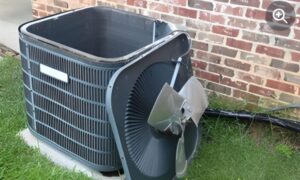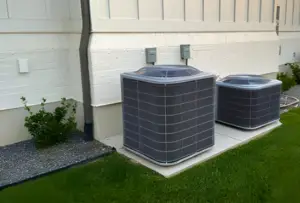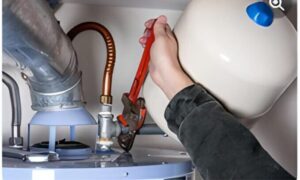When it comes to achieving optimal comfort in homes with sky-high ceilings, there are some HVAC secrets that homeowners and contractors should be aware of.
The increased space created by higher ceilings can pose challenges for the HVAC system, leading to potential inefficiencies and higher energy bills.
However, by understanding the impact on the system's workload, implementing proper ductwork design, utilizing ceiling fans effectively, ensuring adequate insulation, and prioritizing regular maintenance, homeowners can create a more comfortable living environment.
In this article, we will uncover these HVAC secrets, providing valuable insights to help homeowners and contractors navigate the unique challenges that come with homes boasting sky-high ceilings.
Impact on HVAC System Workload
The height of ceilings can significantly impact the workload of HVAC systems, leading to potential increases in energy consumption and costs.
Higher ceilings result in a larger volume of space that needs to be heated or cooled by the HVAC system. This increased volume can cause the system to work harder and consume more energy.
When moving from a home with low ceilings to one with high ceilings, it is important to consider the potential impact on energy bills. Properly sizing the HVAC system can help compensate for the elevated ceilings.
Contractors should take into account factors such as square footage, ceiling height, and other variables when determining the appropriate system size. Adequate sizing ensures energy efficiency and prevents excessive workload on the HVAC system.
Ductwork Design Challenges
With the impact of high ceilings on HVAC system workload in mind, addressing the challenges of ductwork design becomes crucial for maintaining optimal energy efficiency and air circulation. High ceilings can reduce HVAC system efficiency due to the movement of hot air, which tends to rise and accumulate at the ceiling during winter. To overcome this, incorporating low- and high-return air registers can help improve air circulation.
In summer, shutting down the lower return and using the high return removes heat from the ceiling, while in winter, the opposite should be done to ensure proper heating distribution. Proper ductwork design, including the placement and design of air registers, is essential for achieving even temperature distribution and maintaining comfort in spaces with high ceilings.
Benefits of Ceiling Fans
Ceiling fans play a crucial role in optimizing comfort and improving energy efficiency in spaces with high ceilings. They offer several benefits that contribute to a better indoor environment.
- Enhanced Air Circulation: Ceiling fans help distribute heated or cooled air more efficiently in rooms with high ceilings. This ensures that the conditioned air reaches all corners of the space, improving overall comfort.
- Seasonal Efficiency: By running fan blades clockwise in winter, ceiling fans remove heat from the ceiling and push it downward, creating a more even distribution of warmth. Reversing the fan's rotation in summer creates a cooling breeze effect, reducing the reliance on HVAC systems and increasing energy savings.
- Energy Savings: Proper use of ceiling fans can help save energy and lower utility bills. By using ceiling fans to supplement HVAC systems, occupants can maintain a comfortable environment while reducing the workload on the HVAC system, resulting in cost savings.
Importance of Insulation
Adequate insulation plays a crucial role in optimizing energy efficiency and maintaining a comfortable indoor environment for homes with high ceilings. Proper insulation helps prevent heat loss in winter and heat gain in summer, reducing the workload on the HVAC system.
Insulating the ceiling can effectively trap the conditioned air within the living space, preventing it from escaping through the roof. Additionally, adding insulation to the attic or roof can further improve energy efficiency by minimizing thermal transfer.
To determine the appropriate insulation levels for high ceilings, it is advisable to consult with professionals who can assess the specific needs of the home. By investing in adequate insulation, homeowners can effectively regulate temperature, minimize energy waste, and enhance overall comfort in their high-ceilinged spaces.
Maintenance and Regular Check-ups
To ensure optimal performance and longevity of the HVAC system in homes with high ceilings, regular maintenance and check-ups are imperative for maintaining a comfortable indoor environment and maximizing energy efficiency. Proper maintenance helps identify and address any potential issues before they escalate, preventing costly repairs and ensuring the system operates at peak efficiency.
Here are three key reasons why maintenance and regular check-ups are crucial for HVAC systems in homes with high ceilings:
- Inspecting ductwork, vents, and air filters: Regular inspections and cleanings of ductwork, vents, and air filters are essential to ensure proper airflow and maximize system efficiency.
- Cleaning and dusting high ceiling areas: Dust and debris can accumulate in hard-to-reach areas, affecting indoor air quality and system performance. Regular cleaning and dusting of high ceiling areas improve air circulation and prevent potential system malfunctions.
- Monitoring thermostat settings: Regularly monitoring and adjusting thermostat settings based on occupancy and weather conditions can optimize energy usage and prevent unnecessary strain on the HVAC system.
Sizing the HVAC System for High Ceilings
Properly sizing the HVAC system for homes with high ceilings is crucial for ensuring optimal comfort and energy efficiency. The increased ceiling height in these homes creates a larger space that needs to be heated or cooled, which can lead to higher energy bills if not properly addressed. Contractors must consider factors such as square footage, ceiling height, and insulation when sizing the system. Adequate sizing helps maintain energy efficiency and prevents excessive workload on the HVAC system.
Additionally, ductwork design can pose challenges in homes with high ceilings, as hot air tends to rise, causing most of the heat to accumulate at the ceiling level. Incorporating low- and high-return air registers can help improve air circulation and maintain system efficiency.
Proper sizing and design considerations are essential for optimal HVAC performance in homes with high ceilings.
Energy-Saving Tips for Homes With High Ceilings
In order to maximize energy efficiency and decrease utility costs, homeowners with high ceilings can implement a variety of energy-saving strategies. These include:
- Utilizing programmable thermostats: Programming the thermostat to adjust the temperature settings according to the homeowners' schedule can help optimize energy usage and reduce waste.
- Enhancing insulation: Adding insulation to the walls and ceiling can help prevent heat transfer and maintain a comfortable indoor temperature, reducing the workload on the HVAC system.
- Utilizing natural ventilation: Opening windows and using ceiling fans can promote airflow and provide natural cooling, reducing the reliance on the HVAC system.
Implementing these energy-saving strategies can help homeowners with high ceilings reduce their energy consumption, lower utility bills, and improve overall comfort while minimizing their environmental impact.
Frequently Asked Questions
How Can High Ceilings Impact the Workload of an HVAC System?
Higher ceilings increase the space to be heated or cooled by the HVAC system, leading to higher energy bills. Properly sizing the system, incorporating low- and high-return air registers, using ceiling fans, and ensuring adequate insulation can help alleviate the impact.
What Are Some Design Challenges Associated With Ductwork in Homes With High Ceilings?
Design challenges associated with ductwork in homes with high ceilings include the inefficient distribution of air due to hot air rising in winter and the need for incorporating low- and high-return air registers to improve air circulation and remove heat from the ceiling in summer.
How Can Ceiling Fans Help Improve Comfort in Rooms With High Ceilings?
Ceiling fans improve comfort in rooms with high ceilings by distributing heated or cooled air more efficiently. Running fans clockwise in winter removes heat from the ceiling, while reversing their rotation in summer creates a cooling breeze effect, enhancing comfort and reducing reliance on HVAC systems.
Why Is Insulation Important for Homes With High Ceilings?
Insulation is crucial for homes with high ceilings as it helps prevent heat loss in winter and heat gain in summer. Adequate insulation reduces the workload on the HVAC system and improves energy efficiency. Consult professionals for appropriate insulation levels.
What Maintenance Tasks Should Be Performed Regularly for HVAC Systems in Homes With High Ceilings?
Regular maintenance for HVAC systems in homes with high ceilings includes inspecting ductwork, vents, and air filters. Cleaning and dusting high ceiling areas improve air quality. Monitoring thermostat settings and scheduling professional inspections are crucial for optimal system performance.
Conclusion
In conclusion, achieving optimal comfort in homes with sky-high ceilings requires careful consideration and implementation of HVAC secrets.
Proper sizing of the HVAC system, efficient ductwork design, and the use of ceiling fans can all contribute to a more comfortable living environment.
Adequate insulation and regular maintenance are also essential to reduce energy consumption and ensure optimal performance.
By following these strategies, homeowners and contractors can create a comfortable and energy-efficient space in homes with elevated ceilings.







